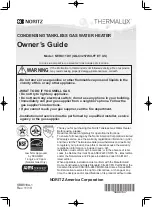
25
VERTICAL TERMINATION INSTALLATION
1.
Determine the location for the termination(s).
2.
If installing only the vent (exhaust) piping in a Power Vent
configuration vertically through the roof; ensure that all exterior
vertical clearance requirements shown in
and
(page 26) are being maintained. These
clearances and those cited by local and national codes must
be maintained.
Note:
On flat roof installations the vent termination must
be a minimum of 24 inches (60 cm) above any
parapet, vertical wall or structure within 10 feet (3
m) horizontally. See
.
3. If installing both intake air and vent piping in a Direct Vent
configuration vertically through the roof; ensure that all exterior
vertical clearance requirements shown in
and
(page 26) are being maintained. These
clearances and those cited by local and national codes must
be maintained.
Note:
On flat roof installations the intake air and the vent
terminations must be a minimum of 24 inches (60
cm) above any parapet, vertical wall or structure
within 10 feet (3 m) horizontally. See
4.
If installing only vent piping in a Power Vent configuration
vertically through the roof the following instructions must be
followed:
•
The vent termination must be oriented facing downward
.
•
The bottom edge of vent termination must be a
minimum of 12 inches (30 cm), 18 inches (45 cm) in
Canada, above average or expected snow level as
.
5.
If installing both intake air and vent piping in a Direct Vent
configuration vertically through the roof the following instructions
must be followed:
•
The intake air and vent pipes must penetrate the same
•
The intake air and vent terminations must be oriented
facing downward and in the same direction as shown
•
The intake air and vent terminations must have a
minimum separation of 24” (61 cm) measured on
center line as shown in
. In colder
climates this separation should be increased to at least
48 inches (122 cm).
•
The bottom edge of the intake air and vent terminations
must be a minimum of 12 inches (30 cm), 18 inches (45
cm) in Canada, above the average or expected snow
6. When the intake air and/or vent piping from multiple water
heaters will terminate in the same location the vent terminations
can be grouped together in close proximity 0 inches/touching.
Intake air terminations can also be grouped together in close
proximity 0 inches/touching.
•
The distance between the closest vent and intake air
terminations must be a minimum of 24 inches (61 cm)
as shown in
. In colder climates
this separation should be increased to at least 48
inches (122 cm).
7.
Cut a four-inch (10 cm) diameter hole for three-inch pipe or 5
inch (13 cm) diameter hole for four-inch pipe where the pipe(s)
will pass through the roof.
18 inches (45 cm) or less in length.
3” PIPE FACTORY INSTALLED
INTAKE AIR
COMBUSTION BLOWER
FACTORY INSTALLED
INTAKE AIR TEE
FITTING
1/2 INCH
BRANCH
HOSE BARB FITTING FOR
BLOCKED INTAKE AIR
SWITCH SENSING TUBE
FERNCO
COUPLING
Figure 19. Intake Air Connection
INSTALL TEE FITTING AS CLOSE TO WATER HEATER
INTAKE AIR CONNECTION AS POSSIBLE
FIELD SUPPLIED
3” x 3” x 1/2” TEE
WITH HOSE BARB
FITTING INSTALLED
FACTORY
INTAKE AIR
CONNECTION
INTAKE
AIR
PIPING
CONNECT FIELD
SUPPLIED FLEXIBLE
DRAIN HOSE TO BARB
FITTING AND FORM A
LOOP WATER TRAP IN
DRAIN HOSE
RUN DRAIN HOSE
TO SUITABLE FLOOR
DRAIN SEPARATELY
FROM OTHER
CONDENSATE DRAINS
Figure 20. Intake Air Condensate Tee Installation
DIRECT VENT AIR INTAKE MOISTURE PROTECTION
The air intake piping in a direct vent system will normally not
have any moisture accumulation in it. However, in certain cases,
moisture may build up and needs to be drained. Typical situations
include, but are not limited to:
•
Cold outdoor temperature, particularly if the air inlet is
short
•
Heater being used mostly for space heating
•
Air inlet pipe has vertical rise near the heater
Installations with any of these conditions are required to provide a
moisture drain with a trap that flows to a waste drain. See
. A horizontal section of the air inlet pipe, near the heater should
include a 3” x 3” x 1/2” tee and a hose barb fitting to drain the
water. The tee should be as close to the heater as is practical.
The drain tubing in any installation should have a loop trap and
flow to an appropriate waste drain. The air intake drain line must
be entirely separate from the exhaust vent outlet condensate line.
Содержание SUF 60120 THRU
Страница 67: ...67 WIRING DIAGRAM Figure 67 Wiring Diagram...
Страница 77: ...77 NOTES...
Страница 78: ...78 NOTES...
Страница 79: ...79 NOTES...
















































